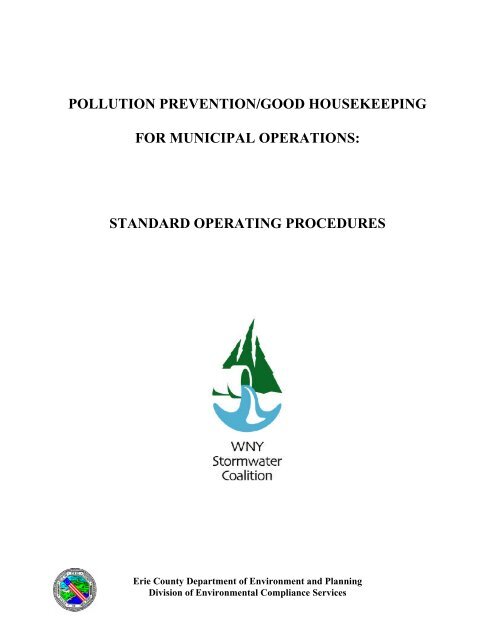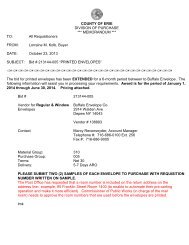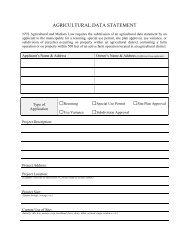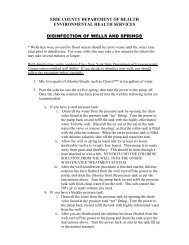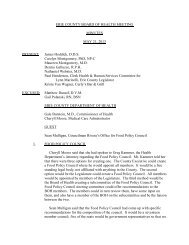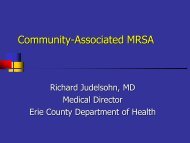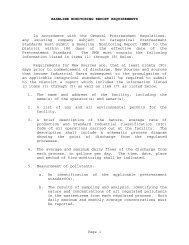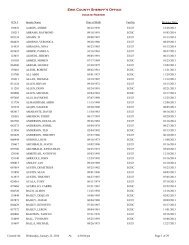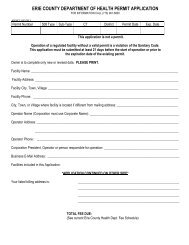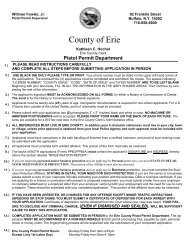Pollution Prevention/Good Housekeeping For ... - Erie County
Pollution Prevention/Good Housekeeping For ... - Erie County
Pollution Prevention/Good Housekeeping For ... - Erie County
- No tags were found...
You also want an ePaper? Increase the reach of your titles
YUMPU automatically turns print PDFs into web optimized ePapers that Google loves.
POLLUTION PREVENTION/GOOD HOUSEKEEPINGFOR MUNICIPAL OPERATIONS:STANDARD OPERATING PROCEDURES<strong>Erie</strong> <strong>County</strong> Department of Environment and PlanningDivision of Environmental Compliance Services
POLLUTION PREVENTION/GOOD HOUSEKEEPING FOR MUNICIPAL OPERATIONS:STANDARD OPERATING PROCEDURESTABLE OF CONTENTS1. STORMWATER INTRODUCTION2. LANDSCAPING AND LAWN CARE3. SPILL RESPONSE AND PREVENTION4. PEST CONTROL5. PET WASTE COLLECTION6. SEPTIC SYSTEM MANAGEMENT7. VEHICLE/EQUIPMENT MAINTENANCE8. VEHICLE/EQUIPMENT WASHING9. ROADWAY AND BRIDGE MAINTENANCE10. ALTERNATIVE DISCHARGE OPTIONS FOR CHLORINATED WATER11. HAZARDOUS AND WASTE MATERIALS MANAGEMENT12. OPERATIONAL BY PRODUCTS/WASTES13. CATCH BASIN AND STORM DRAIN SYSTEM CLEANING14. STREET CLEANING AND MAINTENANCE15. ROAD SALT STORAGE AND APPLICATION16. ROAD KILL COMPOSTING OPERATIONS17. MARINA OPERATIONS18. CONSTRUCTION AND LAND DISTURBANCE
Standard Operating Procedures for:Spill <strong>Prevention</strong>Purpose: to prevent contamination of stormwater by using proper washing techniques, proper washing locations, and proper disposal of wash water1. Monitor equipment storage areas, materials storage areas, and waste storage areas, checking for: fluid leaks, uncovered containers, and deteriorating labelsand/or containers, and correct any problems that are noted.Suggested frequency- daily2. Inspect secondary containment systems (i.e. oil, fuel storage tanks) as necessary, and empty them as necessary. Suggested frequency- monthly3. Monitor oil/water separators and their downstream discharges. An oily discharge indicates that the unit is either not functioning properly or needs to be“pumped out”.Suggested frequency- monthly4. Install oil absorbent materials in floor drains and/or catch basins, and inspect, remove/replace as appropriate. Suggested frequency- monthly5. Monitor floor drains and storm receiver inlets and outlets for excessive amounts of contaminants, and clean out as necessary.Suggested frequency - monthly6. Remove spilled salt from salt loading area, and use or store Suggested frequency - daily7. Document any/all inspection activities on the proper forms
Standard Operating Procedures for:Spill ResponsePurpose: to prevent contamination of stormwater by using proper washing techniques, proper washing locations, and proper disposal of wash water1. Municipal* personnel will close (or limit traffic flow around) the affected portion of any municipal roadway or right-of-way to the extent necessary.2. Municipal personnel are to provide written information (Attachment #1) to the spiller of the material which informs the "spiller" of legal responsibilities toreport the spill to the New York State Department of Environmental Conservation (NYSDEC) and to clean up the spill.3. Municipal personnel are to assist by providing any available communications equipment (phone, portable radio, etc.) to the "spiller" for notification to hissupervisor, the NYSDEC (1-800-457-7362), and/or the cleanup contractor of the occurrence of the spill.4. No municipal personnel are to engage in spill abatement, remediation, or any other spill cleanup activities.5. No municipal personnel are to allow contaminated debris/material to be staged or stored at any municipal facility.6. A Spill Information <strong>For</strong>m (Attachment #3) is to be completed by municipal personnel that respond to the spill.7. A copy of the completed Spill Information <strong>For</strong>m is to be filed and maintained at a central repository at a dedicated municipal location within five workingdays of the incident.(* The word “municipal” in 1-5 above should be replaced by the name of your municipality)
ATTACHMENT #1NOTIFICATION OF SPILLS SHOULD BE MADE WITHIN 2 HOURS OF THE OCCURRENCEOF THE SPILL TO:NEW YORK STATE DEPARTMENT OF ENVIRONMENTAL CONSERVATION716-851-7220 (Region 9 office)OR1-800-457-7362 (24 HOURS)
ATTACHMENT #2SPILL INFORMATION FORMSpillerSpill Logistics:Company Street Location:City State/Zip Street:Municipality: Contact PhoneVehicle License#Date/Time of SpillAdditional Information:Cause of Spill:Product Spilled:Notification to (Your) Municipality (date/time):Cleanup Contractor:Quantity:Person Notified:Phone:Resource Affected? (Yes/No)Land:MS4: (identify section/outfall)Surface Water: (name of waterbody)Stwtr/PPGHSpillSOP.doc
Standard Operating Procedures for:Pest ControlPurpose: to prevent contamination of stormwater by pesticides which can be toxic to aquatic life and may contaminate receiving waters1. Purchase only enough pesticides for 1 year, and store properly Suggested frequency – always2. Adopt Integrated Pesticide Management techniques Suggested frequency – always3. Adopt alternatives to pesticides options Suggested frequency - always4. Eliminate food, water, harborage for pests by implementing routine inspections Suggested frequency – once/week5. Inspect pest traps regularly, remove and properly dispose of dead pests Suggested frequency – once/week6. Minimize pesticide application, use non toxic/lowest toxicity pesticides - (glue boards) Suggested frequency – as warranted7. Do not apply pesticides immediately before/during rain events Suggested frequency - alwaysStwtr/PPGH Pest Control SOP.doc
Standard Operating Procedures for:Pet Waste CollectionPurpose: to prevent contamination of stormwater via contact with pet related wastes1. Check for pet waste (i.e. feces, food wastes) each day; once at the beginning of the work day, once at the end of the work day.Suggested frequency – 2x per day2. Remove all pet waste, and dispose of properly. Preferred method of disposal is into a toilet for disposal at either a municipal wastewater treatment plant or aseptic system.Suggested frequency – 2x/day3 Wash the affected areas with a disinfectant soap and hot water, and rinse to a sanitary sewer (if available) or to a vegetated area.Suggested frequency – 2x/day4. Document any/all inspection activities on the proper formsStwtr/PPGH PET WASTE Coll.doc
Standard Operating Procedures for:Septic System ManagementPurpose: to prevent contamination of stormwater that may contact septic system efluents1. Physically mark the locations of each of the appurtenances that make up the system - septic tank/lid, distribution lines, distribution box, absorption field orsand filter, chlorination tank, and outlet. Then, make a site sketch of the system, and file that documentSuggested frequency – at time of construction/replacement2. To prevent damage, never allow heavy equipment to travel on top of the system3. Prevent materials that are not readily decomposed (i.e. cigarette butts, plastic items, trash) from entering the systemSuggested frequency – continuous4. Minimize solids loading by avoiding the use of a garbage disposal, and minimize hydraulic loading by “spreading out” the processes that use waterSuggested frequency – continuous5. Maintain vegetation (optimally, grass) that grows on the system by mowing regularly. Remove all woody vegetative growth.Suggested frequency – as needed6. Inspect the system, looking for evidence of problems, such as sewage odors, backup of wastewater in sewer lines or the distribution box, “ponding” ofwastewater on the ground’s surface at the system’s componentsSuggested frequency- monthly7. Pump out the septic tank as needed Suggested frequency– once/year8. Maintain records of inspections, pump outs. Store ontractor information where it is readily available.Suggested frequency - continuous9. Document any/all inspection activities on the proper formsStwtr/PPGH Septic sys mgmt SOP.doc
Standard Operating Procedures for:Vehicle and Equipment MaintenancePurpose: to prevent contamination of stormwater by using proper maintenance techniques, proper maintenance locations, and retrofitting infrastructure1. Conduct maintenance work indoors – dedicate specific vehicle bays, seal floor drain systemsSuggested frequency – at time of construction/replacement2. If work is performed outside, protect stormwater drainage conveyances from spills Suggested frequency – continuous3. Clean up spilled materials immediately, using dry methods (absorbents) Suggested frequency – continuous4. Install oil/water separators where necessary Suggested frequency – at time of construction5. Rinse grass from lawn care equipment over permeable, vegetated areas Suggested frequency– continuous6. Never leave vehicles/equipment unattended while refueling Suggested frequency - continuous7. Document any/all inspection activities on the proper formsStwtr/PPGH Veh-Equip Maint SOP.doc
Standard Operating Procedures for:Vehicle and Equipment WashingPurpose: to prevent contamination of stormwater by using proper washing techniques, proper washing locations, and proper disposal of wash water1 Designate a specific vehicle washing bay/facility – the wastewater from the floor drain should flow into an oil/water separator – the treated wastewatershould flow to a municipal sanitary sewer line, if possible. If a sanitary sewer is not available, a wastewater permit must be obtained for the floor draindischarges.Suggested frequency – at time of construction/modification2. Close unneeded floor drains Suggested frequency – at time of construction/modification3. Wash vehicles indoors, using only water for washing – DO NOT USE DETERGENTS, as they emulsify oils thereby making the oil/water separatorineffectiveSuggested frequency – continuous4. Equip hoses with automatic shutoff devices and spray nozzles Suggested frequency – continuous5. Inspect oil/water separators and floor drain systems periodically to determine maintenance needs Suggested frequency– once/yearSuggested frequency – continuous6. Document any/all inspection activities on the proper formsStwtr/PPGH veh-Equip wash SOP.doc
Standard Operating Procedures for:Roadway and Bridge MaintenancePurpose: to prevent contamination of stormwater as it flows over debris that is deposited on road infrastructure and bridgesRoadway Maintenance1. Pave only in dry weather Suggested frequency – always2. Cover manholes and catch basins prior to paving, patching, etc. Suggested frequency – always3. Clean all fluid leaks immediately Suggested frequency - always4. Maintain roadside vegetation – restrict pesticide use Suggested frequency – whenever possible5. Sweep/vacuum roadways and shoulders to remove debris, particulate matter Suggested frequency – whenever possibleBridge Maintenance1. Install catch basins instead of scuppers Suggested frequency – at time of construction2. Direct runoff from bridge scuppers/catch basins to vegetated areas Suggested frequency – at time of construction3. Remove debris from bridge scuppers/catch basins routinely Suggested frequency - always4. Sweep bridge deck and structure prior to washing Suggested frequency - always5. Use tarps and vacuums during sandblasting/painting activities Suggested frequency - always6. If bird nests are occupied (includes eggs & chicks) do not perform maintenance Suggested frequency - always7. If flaking paint is present, do not wash Suggested frequency - alwaysStwtr/PPGH Road Bridge Maint SOP.doc
Standard Operating Procedures for:Alternative Discharge Options for Chlorinated WaterPurpose: to prevent contamination of stormwater that may come into contact with pool water or with treated waters from municipal systems1. <strong>For</strong> each source of chlorinated water which will be discharged, determine whether (or not) a sanitary sewer system is available for that discharge.Suggested frequency – at time of construction2. Prior to discharge, allow disinfectant in the pool to dissipate, or dechlorinate. The disinfectant will break down more quickly in sunny conditions. Checkthe residual with the proper test kit –the target residual is 0.2 ppm or lessSuggested frequency – as needed3. If a sanitary sewer is available for discharge, contact the sewer authority/wastewater treatment plant personnel and obtain their guidelines for this activity.Suggested frequency – as needed4. If no sanitary sewer is available, discharge the water at a slow rate (i.e. using a siphon hose) to a vegetated area so that it can be filtered and absorbed, not toa surface water, storm sewer, or ditch where it can potentially harm aquatic life. Suggested frequency - as needed5. Discharge during dry weather conditions only.6. Document any/all inspection activities on the proper formsStwtr/PPGH Alt disch opt for Cl2 water SOP.doc
Standard Operating Procedures for:Hazardous and Waste Materials ManagementPurpose: to prevent contamination of stormwater by properly storing, handling, and disposing of hazardous and waste materials1. Store all materials/wastes in closed, labeled containers – if outside storage is necessary, the storage area should be sheltered from the weatherSuggested frequency – continuous2. Designate storage areas away from floor drains (if inside) and storm receivers (if outside) Suggested frequency – continuous3. Install a pretreatment system (oil/water separator) where a potential exists for petroleum products to enter floor drains. Eliminate floor drains if possibleSuggested frequency –at time of construction4. Reduce stocks of materials where viable - use “first in/first out” management techniques Suggested frequency – as needed5. Use least toxic materials Suggested frequency- continuous6. Install secondary containment devices where appropriate Suggested frequency– at time of construction7. Recycle/dispose of materials properly Suggested frequency – continuous8. Do not mix dissimilar wastes in the same containers Suggested frequency - continuous9. Document any/all inspection activities on the proper formsStwtr/PPGH Materials Mgmt SOP.doc
Standard Operating Procedures for:Operational By Products/WastesPurpose: to prevent contamination of stormwater by preventing “illegal” disposal, and by properly storing, handling, and disposing of facility generated and wastesFOR FACILITY GENERATED WASTES:1. Develop a list of wastes, with associated procedures for handling/storage/recycling/disposal, and provide to staff. Instruct all staff to adhere to thisinformation, and to inform the facility manager if new wastes are generated.Suggested frequency – initially, with annual reviews/updates2. Secure the facility to prevent access (fence/lock gates) Suggested frequency – at close of businessFOR MUNICIPAL AREAS THAT ARE SUSCEPTIBLE TO ILLEGAL DUMPING:1. Post/maintain “NO DUMPING” signs, erect barriers to prevent access, illuminate area Suggested frequency – as needed2. Patrol areas Suggested frequency – as needed3. Maintain areas/remove illegally dumped trash/debris Suggested frequency – as needed4. Document any/all inspection activities on the proper formsStwtr/PPGH Op by products-wastes SOP.doc
Standard Operating Procedures for:Catch Basin and Storm Drain System CleaningPurpose: to prevent contamination of stormwater via contact with debris which has been deposited in storm drain systems by performing periodic maintenanceCatch basins1. Identify catch basins that need frequent maintenance, and prioritize Suggested frequency – always2. During cleaning, identify the need for repair of structure (also pertains to manholes, piping)Suggested frequency - always3. Clean catch basins when debris has filled it 1/3 of the way to the outlet Suggested frequency – always4. Inspect/determine the need for cleaning after storm events Suggested frequency - always5. Coordinate catch basin cleaning with related street sweeping events Suggested frequency – alwaysDitches1. When cleaning, remove obstacles/debris Suggested frequency - always2. Cut/remove vegetation (as opposed to ditch scraping) to allow capture of sediment Suggested frequency – whenever possible3. ID excessive siltation in ditch - may indicate the need to re-grade the ditch Suggested frequency - always4. During ditch scraping, maintain vegetation (downstream in ditch) to capture sediment Suggested frequency – alwaysStwtr/PPGH Catch Basin – Storm Drain SOP.doc
Standard Operating Procedures for:Street Cleaning and MaintenancePurpose: to prevent contamination of stormwater as it comes into contact with debris that has been deposited on roadways1. Consider shouldered roads instead of curbed roads Suggested frequency – at time of construction2. Coordinate activity with catch basin cleaning Suggested frequency – always3. Prioritize street cleaning, perform maintenance routinely Suggested frequency – always4. Maintain roadside vegetation, re-seed as necessary Suggested frequency – whenever possible5. Maintain equipment – address fluid leaks immediately Suggested frequency – at scheduled times5. Cover catch basins/storm inlets prior to street maintenance Suggested frequency - always6. Collect leaves (Autumn) Suggested frequency – as warranted7. Sweep sand/salt residues (Spring) Suggested frequency – as warrantedStwtr/PPGH Street Clean & Maint SOP.doc
Standard Operating Procedures for:Road Salt Storage and ApplicationPurpose: to prevent contamination of stormwater by using proper storage techniques, and improving application techniques of deicing materials1. Store road salt, road salt/sand mixtures in properly sized, covered structure Suggested frequency – at time of construction2. Order/request salt delivery prior to the onset of winter weather to enable immediate storage (i.e. in salt barn, under tarp) to prevent runoffSuggested frequency – at time of purchase3. Unload salt deliveries directly into barn, or move inside immediately Suggested frequency each delivery4. Store salt on highest ground possible Suggested frequency – continuous5. Cover salt loading area or “build into” storage shed Suggested frequency – at time of construction6. Control spreading speeds, use a wetting agent to minimize “bounce” Suggested frequency- as needed7. Control spread patterns to concentrate material where it is most effective Suggested frequency – continuous8. Inspect salt storage area, salt loading area to ensure that salt is not exposed to weather Suggested frequency– once/day9. Minimize salt usage by calibrating salt application equipment periodically Suggested frequency - weekly10. Minimize salt spillage by not exceeding capacities of equipment (i.e. front end loader, truck bed) during loading operationsSuggested frequency – always11. Always plow when de-icing roads Suggested frequency - continuous12. Reference/use Chemical Application Rate Charts Suggested frequency – continuous13. Consider alternative treatments (plow only, erect snow fence) that do not require the application of materials Suggested frequency – as applicable14. Document any/all inspection activities on the proper forms Suggested frequency – continuousStwtr/PPGH Road Salt SOP.doc
Standard Operating Procedures for:Road Kill Composting OperationsPurpose: to prevent contamination of stormwater that may come into contact with compost piles1. Identify the proper location for siting the compost pile/windrow. It should be on a well drained, impervious surface with minimal slope, at least 200 ft. froma receiving water body or wetland. Also, determine the types of materials/dead animals that will be composted.Suggested frequency – prior to construction2. Obtain the proper materials to construct the compost pile Suggested frequency – prior to construction3. Perform visual inspections regularly – check for odors, exposed carcasses, leachate, and utilize the inspection checklistSuggested frequency – as needed4. Document any/all inspection activities on the proper formsStwtr/PPGH COMPOST OPS SOP.doc
Standard Operating Procedures for:Marina OperationsPurpose: to prevent contamination of stormwater via contact with debris, wastes, fuels, or other materials that are used at marinas1. Site boat maintenance areas away from the water and from storm sewer receivers Suggested frequency- at time of construction2. Stabilize shoreline Suggested frequency- at time of construction3. Install vegetated buffer strips to minimize impervious areas Suggested frequency- at time of construction4. Inspect/maintain trash cans, pump out stations, fish cleaning stations Suggested frequency- daily5. Inspect fueling stations for leaks, spills other problems Suggested frequency- daily6 Check educational display – ensure that educational brochures are well stocked Suggested frequency- daily7. Document any/all inspection activities on the proper formsStwtr/PPGH Marina Ops.doc
Standard Operating Procedures for:Construction and Land DisturbancePurpose: to prevent contamination of stormwater runoff by preventing contact with barren soils and/or capturing silt and sediment prior to leaving the site1. Install sediment barriers prior to land disturbance, and maintain Suggested frequency – always2. Maintain native vegetation, if possible Suggested frequency – always3. Install sediment control devices prior to land disturbance, and maintain Suggested frequency – always4. Stabilize site Suggested frequency - always5. Maximize opportunities for infiltration Suggested frequency - always6. Minimize compaction of soils, limit grading to small areas Suggested frequency – whenever possible7. Divert stormwater away from barren slopes Suggested frequency – whenever possibleStwtr/PPGH Const Land Disturb SOP.doc


